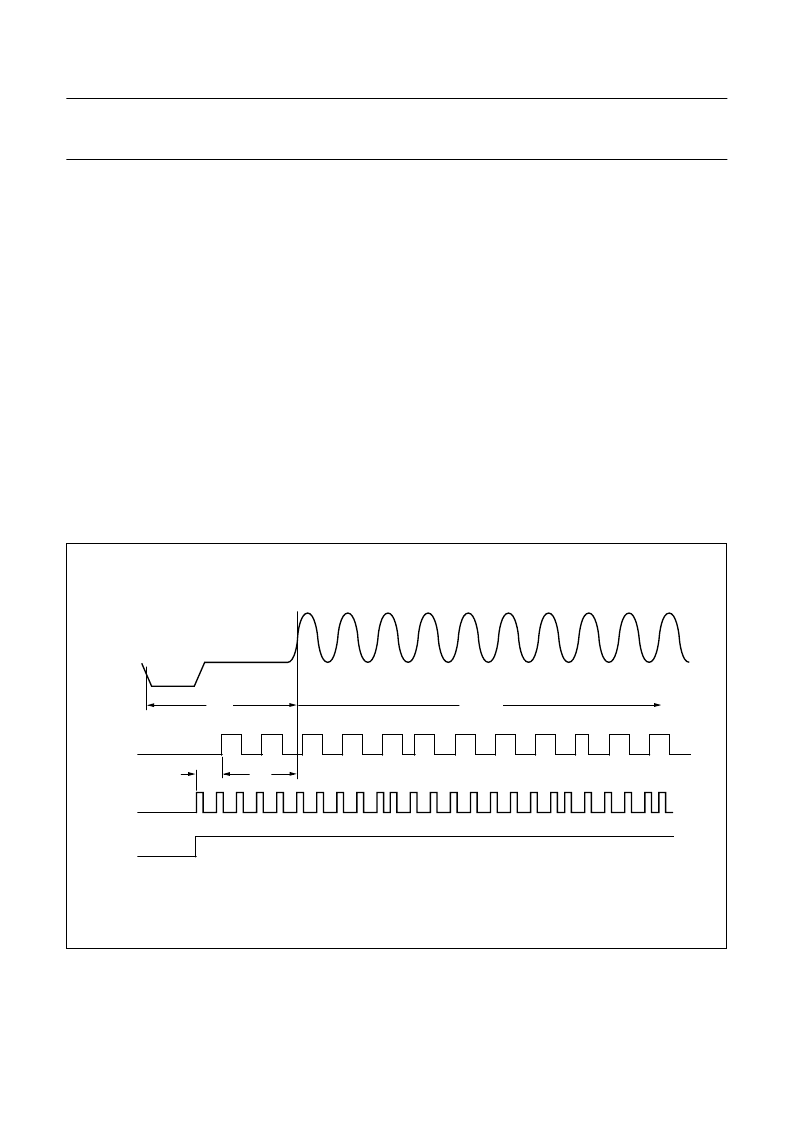- 您現(xiàn)在的位置:買賣IC網(wǎng) > PDF目錄372113 > SAA7126H (NXP SEMICONDUCTORS) Digital video encoder PDF資料下載
參數(shù)資料
| 型號(hào): | SAA7126H |
| 廠商: | NXP SEMICONDUCTORS |
| 元件分類: | 顏色信號(hào)轉(zhuǎn)換 |
| 英文描述: | Digital video encoder |
| 中文描述: | COLOR SIGNAL ENCODER, PQFP44 |
| 封裝: | 10 X 10 MM, 1.75 MM HEIGHT, PLASTIC, SOT-307-2, QFP-44 |
| 文件頁數(shù): | 32/40頁 |
| 文件大?。?/td> | 155K |
| 代理商: | SAA7126H |
第1頁第2頁第3頁第4頁第5頁第6頁第7頁第8頁第9頁第10頁第11頁第12頁第13頁第14頁第15頁第16頁第17頁第18頁第19頁第20頁第21頁第22頁第23頁第24頁第25頁第26頁第27頁第28頁第29頁第30頁第31頁當(dāng)前第32頁第33頁第34頁第35頁第36頁第37頁第38頁第39頁第40頁

1999 May 31
32
Philips Semiconductors
Product specification
Digital video encoder
SAA7126H; SAA7127H
Teletext timing
Time t
FD
is the time needed to interpolate input data TTX
and insert it into the CVBS and VBS output signal, such
that it appears at t
TTX
= 9.78
μ
s (PAL) or t
TTX
= 10.5
μ
s
(NTSC) after the leading edge of the horizontal
synchronization pulse.
Time t
d(pipe)(MP)
is the pipeline delay time introduced by the
source that is gated by TTXRQ in order to deliver TTX
data. This delay is programmable by register TTXHD. For
every active HIGH state at output pin TTXRQ, a new
teletext bit must be provided by the source (new protocol)
or a window of TTXRQ going HIGH is provided and the
number of teletext bits, depending on the chosen TTX
standard, is requested at input pin TTX (old protocol).
Since the beginning of the pulses representing the TTXRQ
signal and the delay between the rising edge of TTXRQ
and valid teletext input data are fully programmable
(TTXHS and TTXHD), the TTX data is always inserted at
the correct position after the leading edge of outgoing
horizontal synchronization pulse.
Time t
i(TTXW)
is the internally used insertion window for
TTX data; it has a constant length that allows insertion of
360 teletext bits at a text data rate of 6.9375 Mbits/s
(PAL), 296 teletext bits at a text data rate of 5.7272 Mbits/s
(world standard TTX) or 288 teletext bits at a text data rate
of 5.7272 Mbits/s (NABTS). The insertion window is not
opened if the control bit TTXEN is zero.
Using appropriate programming, all suitable lines of the
odd field (TTXOVS and TTXOVE) plus all suitable lines of
the even field (TTXEVS and TTXEVE) can be used for
teletext insertion.
Fig.14 Teletext timing.
handbook, full pagewidth
ti(TTXW)
tTTX
tPD
tFD
CVBS/Y
TTX
TTXRQ (new)
TTXRQ (old)
text bit #:
1
2
3
4
5
6
7
8
9
10 11
12
13
14
15
16
17
18 19 20
21
22
23
24
MHB504
相關(guān)PDF資料 |
PDF描述 |
|---|---|
| SAA7127 | Digital video encoder |
| SAA7127H | Digital video encoder |
| SAA7128A | Digital video encoder |
| SAA7128AH | Digital video encoder |
| SAA7129AH | Digital video encoder |
相關(guān)代理商/技術(shù)參數(shù) |
參數(shù)描述 |
|---|---|
| SAA7127 | 制造商:PHILIPS 制造商全稱:NXP Semiconductors 功能描述:Digital video encoder |
| SAA7127H | 制造商:PHILIPS 制造商全稱:NXP Semiconductors 功能描述:Digital video encoder |
| SAA7128 | 制造商:PHILIPS 制造商全稱:NXP Semiconductors 功能描述:Digital video encoder |
| SAA7128A | 制造商:PHILIPS 制造商全稱:NXP Semiconductors 功能描述:Digital video encoder |
| SAA7128AH | 制造商:PHILIPS 制造商全稱:NXP Semiconductors 功能描述:Digital video encoder |
發(fā)布緊急采購,3分鐘左右您將得到回復(fù)。